Disposable cameras or single-use cameras let you experience the nostalgic way of capturing moments in this digital age of snapshots and instant filters.
These pocket-size wonders are travel-friendly, don’t need batteries or charging, are easy to use and some of them are even eco-friendly.
Moreover, the photos taken with disposable cameras often have a distinct, vintage look with grainy textures and soft focus, which can be a desired aesthetic for many.
But how does one pinpoint the ideal disposable camera in a sea of several choices?
Here you can discover the best disposable cameras, handpicked by our team in collaboration with expert photographers.
To understand the criteria and features that shaped our selection, we recommend checking out our “Buying Guide”. Additionally, explore detailed reviews of our curated products for comprehensive insight.
- Fujifilm Disposable Camera – Best Overall and Budget-Friendly Disposable Camera
- KODAK Disposable Camera – Best Disposable Camera for Weddings
- Ilford Disposable Camera – Best Disposable Camera for Vintage Photography
- Agfa Disposable Camera – Best Disposable Camera for Underwater Photography
- Solo Disposable Camera – Best Disposable Camera for Travel
Outline
ToggleBest Disposable Cameras Table
| Best Disposable Cameras | Film Format | Focusing Range | Built-in Flash | Buy Now |
|---|---|---|---|---|
| Fujifilm Disposable Camera | 35mm | 1 Meter To Infinity | Yes | Check On Amazon |
| KODAK Disposable Camera | 35mm | 1 Meter To Infinity | Yes | Check On Amazon |
| Ilford Disposable Camera | 35mm | 1 Meter To Infinity | Yes | Check On Amazon |
| Agfa Disposable Camera | 35mm | 1 Meter To Infinity | Yes | Check On Amazon |
| Solo Disposable Camera | 35mm | 1 Meter To Infinity | Yes | Check On Amazon |
In-Depth Reviews of The Best Disposable Cameras 2024
1. Fujifilm Disposable Camera
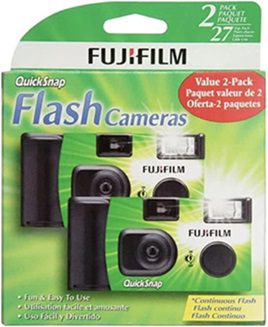
Key Specifications
- Number of exposures: 27
- Film Type: Color
- Built-Flash: Yes
- ISO: 400
The Fujifilm QuickSnap Flash 400 is not just any disposable camera; it is a testament to Fujifilm’s commitment to quality even in their one-time-use offerings. Designed for longevity beyond typical disposable models, its robust build ensures durability.
This disposable camera is user-friendly and ready to use straight out of the box. Each package provides two cameras, each preloaded with Superior X-TRA 400 35mm films, ensuring vibrant captures.
The camera’s in-built flash further enhances its versatility, making it apt for both sunlit outdoor adventures and dimly lit indoor settings. With a focusing range from 1 meter to infinity, it is equipped to capture a wide array of scenes.
Customer Feedback
Users appreciate the Fujifilm QuickSnap for its impressive flash range of up to 10 feet and its cost-effectiveness. However, some note that its performance in low-light conditions is moderate.
2. KODAK Disposable Camera
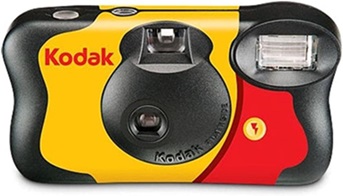
Key Specifications
- Number of exposures: 27
- Film Type: Color
- Built-Flash: Yes
- ISO: 800
The KODAK FunSaver disposable camera stands out with its user-friendly design and the promise of the KODAK brand. Equipped with a built-in flash, it is versatile enough to capture memories regardless of the time of day or lighting conditions.
The convenience is further amplified with the preloaded 800 ISO Kodak Max single-use camera film, eliminating the need for manual loading, and ensuring you are always ready to shoot. The camera’s design ensures that accidental exposures are a thing of the past; simply hand over the entire unit to your photo lab.
A bonus is the brand’s commitment to the environment, with an over 70% recycling rate for this model in the U.S. The dedicated viewfinder enhances the photography experience, aiding in composing shots with precision.
Customer Feedback
Many users commend the KODAK FunSaver for its simplicity and ease of disassembly. However, a point of contention remains its predominantly plastic construction, which some feel detracts from its overall build quality.
3. Ilford Disposable Camera
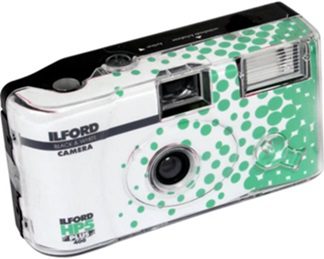
Key Specifications
- Number of exposures: 27
- Film Type: Black and White
- Built-Flash: Yes
- ISO: 400
The Ilford HP5 Plus Disposable Camera is not just another single-use camera; it’s a blend of Ilford’s legacy and modern convenience. With an in-built flash, it ensures that lighting conditions don’t hinder your creativity.
Its robust build sets it apart from many disposable counterparts, offering a tactile, sturdy feel. Preloaded with HP5 PLUS 400 ISO 35mm film, it promises sharp, high-contrast black and white images.
The camera’s focus range, spanning from 1 meter to infinity, ensures versatility in capturing varied scenes. While it is a single-use camera, the quality of the resultant photographs is reminiscent of classic film photography, delivering images with depth, texture, and emotion.
Customer Feedback
Users frequently praise the Ilford HP5 Plus for its robust construction and the distinct quality of its black-and-white images. However, some users note its limitation to only black and white film, missing out on the vibrancy of color captures.
4. Agfa Disposable Camera
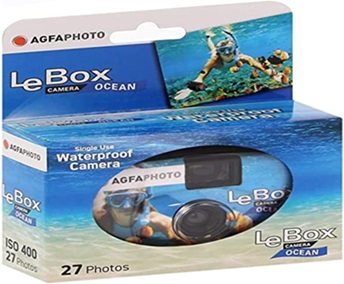
Key Specifications
- Number of exposures: 27
- Film Type: Color
- Built-Flash: No
- ISO: 400
The Agfa LeBox Ocean 400 stands out with its unique underwater capabilities, allowing users to dive up to 10 feet and capture the aquatic world in all its splendor. Whether it is snorkeling amidst vibrant marine life or capturing moments at a beach party, this camera delivers vivid, colorful images.
Its ISO 400 film ensures that each shot, whether under the sun or in subdued lighting, is vibrant and detailed. The camera’s point-and-shoot mechanism ensures that even beginners can capture moments effortlessly.
Designed for immediate use, it comes with pre-loaded batteries, making it a reliable travel companion. Its lightweight design ensures it does not become a burden during adventures, and its simplicity means there is no need for additional accessories.
Customer Feedback
Users have lauded the Agfa LeBox Ocean 400 for its unparalleled underwater photography capabilities and its user-friendly design, especially for novices. However, some have pointed out its limitation of 27 exposures and its disposable nature, which might not align with eco-friendly preferences. Additionally, seasoned photographers might find it lacking in advanced features.
5. Solo Disposable Camera
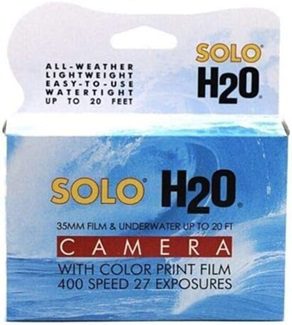
Key Specifications
- Number of exposures: 27
- Film Type: Color Negative Film
- Built-Flash: No
- ISO: 400
The Solo H2O Single Use Underwater Camera is not just any disposable camera; it is your adventure companion. Compact enough to fit in your pocket or purse, it is ready to capture sharp images on land, underwater (up to 20 feet), or in any challenging environment like sand or snow.
With a focus-free lens, it ensures clarity in every shot, whether you are capturing a close-up or a distant scene. Pre-loaded with 27 exposures of color negative film, it promises vibrant memories of every adventure. Its ISO 400 film speed ensures optimal performance in varied lighting conditions.
The camera’s design prioritizes convenience, eliminating the need for manual adjustments. Simply point, shoot, and let the camera work its magic. When it is time to relive the memories, the film can be developed at any photo-finisher, ensuring prompt and convenient processing.
Customer Feedback
Users appreciate the Solo H2O for its versatility, especially its underwater capabilities. Its ease of use makes it a favorite among beginners and those looking for a hassle-free photography solution. However, some users have expressed concerns about its single-use nature, which may not align with eco-friendly preferences.
What is a Disposable Camera?
A disposable camera, often referred to as a single-use camera, is a pre-loaded film camera designed for one-time use. Unlike traditional film cameras, once the film is used up, the camera is returned to the store for film development rather than reloading it with a new film roll. Popular in the 1990s and early 2000s for events like weddings or vacations, they offered a convenient and affordable way to capture memories without the need for a more expensive, permanent camera.
How to Choose The Best Disposable Camera?
In the realm of photography, disposable cameras offer a unique blend of nostalgia and convenience. But with a myriad of options available, how do you select the perfect one? This comprehensive buying guide for disposable cameras is designed to assist you in making an informed decision.
1. Film Type
In the world of disposable cameras, the type of film you choose plays a pivotal role in the outcome of your photographs. There are two options (colour film, black and white film), you can choose from.
Opting for a Color Film is perfect for those who wish to encapsulate the world in its full spectrum. It is the go-to for everyday photography, adept at seizing the vibrancy and dynamism of scenes, from sunlit landscapes to colorful festivities.
On the other hand, Black and White Film transports you to an era of timeless elegance. Stripping away the hues, it lays bare the raw emotions and moods of a moment, offering a profound depth and a classic touch that color sometimes overshadows.
2. Number of Exposures
The next factor to consider while looking for the best disposable camera is to check – the number of exposures it offers. Essentially, the term “exposures” refers to the number of photographs you can take with a single camera.
Most disposable cameras on the market offer either 16 to 39 exposures. This limitation is due to the pre-loaded film inside the camera.
Your choice between these two options should hinge on your photographic needs. It is all about anticipating your needs and ensuring you do not run out of shots at a crucial moment.
Opting for fewer exposures gives you a slight edge, allowing for those few extra shots that might make all the difference. However, if you are just looking for casual photography or a quick adventure, a higher exposure camera might suffice.
3. Understanding ISO or Film Speed
ISO, an acronym derived from the International Standards Organization, gauges the sensitivity of film to light. In the context of digital cameras, users can adjust the ISO, but with film, it remains constant.
A heightened ISO, often seen at 800 in many top-tier disposable cameras ensures versatility across diverse lighting scenarios. Conversely, disposable cameras with an ISO ranging between 200 and 400 are more attuned to outdoor settings bathed in sunlight.
Beyond just ISO, the presence of a flash can significantly influence the quality of your captures, offering a compensatory light source in varied environments. For those navigating fluctuating light conditions, a disposable camera boasting a flash and a robust ISO is ideal.
However, for budding photographers keen on honing their craft, a camera with a modest ISO can be a delightful tool, challenging them to master outdoor shots.
4. Lens Quality
The lens is the eye of any camera, dictating the clarity and quality of the images captured. When on the hunt for a disposable camera, it is essential to prioritize those with superior lens quality. Such a choice ensures that your fleeting moments are captured with the utmost clarity and brilliance.
Some disposable cameras, despite their transient nature, are equipped with lenses that yield notably sharper and clearer images. These lenses can better focus on subjects, reduce distortions, and enhance overall image fidelity.
5. Shutter Speed
Disposable cameras come with distinct preset configurations. A faster shutter speed captures images in a shorter amount of time, making it ideal for well-lit conditions. On the other hand, a slower shutter speed keeps the shutter open longer, drawing in more light, which is beneficial for dimly lit scenarios.
6. Aperture
The aperture is essentially the opening in the camera’s lens. A larger aperture permits a greater amount of light to enter, enhancing the camera’s ability to shoot in various lighting conditions. Most disposable cameras typically feature an aperture size around f/11, which is on the smaller side, limiting the amount of light that can enter.
7. Waterproofing
When it comes to capturing memories in aquatic environments, waterproofing becomes a game-changer. Waterproof disposable cameras are meticulously crafted to resist water intrusion, ensuring the internal components remain dry and functional even when submerged. Their robust design not only shields against accidental splashes but also empowers adventurers to delve beneath the water’s surface, immortalizing the mesmerizing world below. So, if you are taking photos near pools, beaches or under rain, these waterproof disposable cameras can be beneficial.
8. Design and Ergonomics
The design of a disposable camera goes beyond mere aesthetics; it plays a pivotal role in the user’s experience. While many disposable cameras share a generic design blueprint, subtle variations can make a world of difference. Whether it is a sleek finish or a retro vibe, the design can resonate with a user’s personality.
Ergonomics focuses on the camera’s design tailored to user comfort, ensuring it fits snugly in the hand, allowing for effortless operation. Meanwhile, aesthetic nuances cater to individual style preferences, making the camera not just a tool but an accessory.
9. Environmental Considerations
In an era increasingly conscious of environmental impact, the ability to dispose of cameras raises valid concerns. However, several brands have taken strides towards sustainability, introducing recycling initiatives for their used products. These programs ensure that camera components, especially plastics, are repurposed, reducing waste and environmental harm.
For the eco-aware consumer, aligning with brands championing such green practices becomes essential. By opting for brands that prioritize eco-friendly measures, users can enjoy the charm of disposable cameras while also playing a part in preserving the planet for future generations.
Benefits of Disposable Cameras
- Simplicity: Disposable cameras are straightforward to use, making them perfect for beginners or those who prefer a point-and-shoot experience without adjusting settings.
- Cost-Effective: They are generally cheaper than regular cameras, making them a budget-friendly option for occasional photography.
- Travel-Friendly: Their compact and lightweight nature makes them ideal for travelers who do not want to risk losing or damaging more expensive equipment.
- Nostalgic Appeal: The film aesthetic of disposable cameras offers a unique, vintage feel that many people appreciate.
- Ideal For Events: Their affordability makes them great for events like weddings, where multiple cameras can be handed out for candid shots.
- No Maintenance: Unlike regular cameras that might require occasional upkeep, disposable cameras can be used and then handed in for development without any maintenance.
- No Battery Worries: Many disposable cameras operate without batteries, ensuring they are always ready to shoot.
Disposable Cameras – FAQs
Ans: Disposable cameras are ideal for one-time events, travel, or situations where you risk damaging a pricier camera. Reusable cameras are better for consistent photography and offer more control over settings.
Ans: The longevity of a disposable camera hinges on its storage conditions. Cold storage is optimal. While the camera is single-use, the undeveloped film typically lasts up to a year. However, it is best to develop soon after use for optimal photo quality.
Typically, there is an expiry date on the camera’s packaging, indicating peak performance. In warm, moist climates, film quality can degrade. Additionally, if the camera has a flash, its battery might corrode over time. While this will not impact the photos, it is advisable to remove the battery before long-term storage to prevent any damage.
Ans: Many brands and photo labs offer recycling programs for disposable cameras, repurposing parts and reducing waste.
Ans: Modern airport X-ray machines are generally safe for disposable cameras. However, repeated scans might affect film quality, so it is advisable to request a manual check if possible.
Ans: After using up your disposable camera’s film, you will be eager to see the captured moments. Your neighbourhood camera store is a reliable place to process the film. The cost varies based on factors like the number of photos and film type. Local photography outlets are typically equipped to handle such film processing, making it convenient for users.
Ans: There are two essential guidelines for disposable camera usage. Avoid activating the flash for subjects positioned more than 10 feet distant. Refrain from using the flash when aiming at reflective materials like mirrors, glass, or water surfaces, as it can lead to excessively bright, washed-out images.
Ans: Depending on the film’s ISO, disposable cameras can be tailored for various lighting conditions. A camera with a lower ISO film is suited for outdoor brightness, while one with a higher ISO is apt for indoor or subdued light settings. The film type also dictates if the images will be in color or monochrome and the total count of pictures you can capture.
Ans: Even with optimal cold storage, the film’s integrity diminishes over time. It is recommended to process films within a half-year of capturing. Beyond this period, the quality of the images may deteriorate.
Ans: While many disposable camera manufacturers design their products for one-time use, the structure of these cameras allows for disassembly. This means, with some skill and care, you can replace the original film with a new roll. It is a bit of a challenge but entirely feasible.
Ans: Most disposable cameras come equipped with an exposure indicator on the top. This counter displays the number of photos taken. Typically, these cameras allow for up to 27 shots. Once the counter maxes out, the camera has reached its photo limit, signaling it is time to develop the film.
Ans: The longevity of a disposable camera largely depends on its care and handling. As long as it has kept safe from potential damage, it can serve you for an extended period. While refilling the film requires careful handling to avoid damaging the camera’s components, with proper care, a disposable camera can be reused multiple times.
Conclusion
Photography is a captivating art and hobby, but investing in a professional camera can be quite a financial commitment. For those just starting out or wanting to experience the charm of analog or vintage photography, disposable cameras offer an affordable alternative.
In this article, we have highlighted a range of top disposable camera choices for your consideration. If you are seeking further guidance, our detailed buying guide delves into the nuances of disposable cameras. And if decision-making is not your strong suit, we have also spotlighted some of our top recommendations for you.
- Fujifilm Disposable Camera is packed with Superior X-TRA 400 film, the Fujifilm Disposable Camera captures moments with vivid clarity. This camera ensures quality shots, especially with its built-in nighttime flash.
- KODAK Disposable Camera is designed for single use, and boasts the iconic Kodak quality in every shot. With an 800 ISO Kodak Max 35mm film and an in-built flash, it is perfect for capturing memories in various lighting conditions.
- Ilford Disposable Camera is a nod to traditional photography with its unique black and white film output. Ideal for those seeking a vintage touch, this camera promises sharp images with a timeless feel.
Was the guide and product description provided in this article helpful? Did you choose any product on our list of the best disposable cameras? Share your thoughts and experiences in the comment section.

